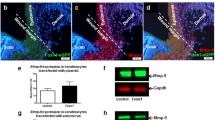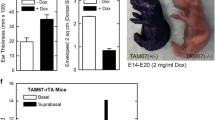Abstract
Aquaporin-3 (AQP3) is a water/glycerol transporting protein expressed strongly at the plasma membrane of keratinocytes. There is evidence for involvement of AQP3-facilitated water and glycerol transport in keratinocyte migration and proliferation, respectively. Here, we investigated the involvement of AQP3 in keratinocyte differentiation. Studies were done using AQP3 knockout mice, primary cultures of mouse keratinocytes (AQP3 knockout), neonatal human keratinocytes (AQP3 knockdown), and human skin. Cells were cultured with high Ca2+ or 1α,25-dihydroxyvitamin D3 (VD3) to induce differentiation. The expression of differentiation marker proteins and differentiating responses were comparable in control and AQP3-knockout or knockdown keratinocytes. Topical application of all-trans retinoic acid (RA), a known regulator of keratinocyte differentiation and proliferation, induced comparable expression of differentiation marker proteins in wildtype and AQP3 null epidermis, though with impaired RA-induced proliferation in AQP3 null mice. Immunostaining of human and mouse epidermis showed greater AQP3 expression in cells undergoing proliferation than differentiation. Our results showed little influence of AQP3 on keratinocyte differentiation, and provide further support for the proposed involvement of AQP3-facilitated cell proliferation.




Similar content being viewed by others
Abbreviations
- AQP:
-
Aquaporin
- RA:
-
All-trans retinoic acid
- VD3 :
-
1α,25-Dihydroxyvitamin D3
References
Bellemère G, Von Stetten O, Oddos T (2008) Retinoic acid increases aquaporin 3 expression in normal human skin. J Invest Dermatol 128:542–548
Bikle DD, Ng D, Tu CL, Oda Y, Xie Z (2001) Calcium- and vitamin D-regulated keratinocyte differentiation. Mol Cell Endocrinol 177:161–171. doi:10.1016/S0303-7207(01)00452-X
Bollag WB, Xie D, Zheng X, Zhong X (2007) A potential role for the phospholipase D2-aquaporin-3 signaling module in early keratinocyte differentiation: production of a phosphatidylglycerol signaling lipid. J Invest Dermatol 127:2823–2831. doi:10.1038/sj.jid.5700692
Cao C, Wan S, Jiang Q, Amaral A, Lu S, Hu G, Bi Z, Kouttab N, Chu W, Wan Y (2008) All-trans retinoic acid attenuates ultraviolet radiation-induced down-regulation of aquaporin-3 and water permeability in human keratinocytes. J Cell Physiol 215:506–516. doi:10.1002/jcp.21336
Eckert RL, Crish JF, Robinson NA (1997) The epidermal keratinocyte as a model for the study of gene regulation and cell differentiation. Physiol Rev 77:397–424
Fisher GJ, Voorhees JJ (1996) Molecular mechanisms of retinoid actions in skin. FASEB J 10:1002–1013
Griffiths CE, Rosenthal DS, Reddy AP, Elder JT, Astrom A, Leach K, Wang TS, Finkel LJ, Yuspa SH, Voorhees JJ et al (1992) Short-term retinoic acid treatment increases in vivo, but decreases in vitro, epidermal transglutaminase-K enzyme activity and immunoreactivity. J Invest Dermatol 99:283–288. doi:10.1111/1523-1747.ep12616626
Hara M, Ma T, Verkman AS (2002) Selectively reduced glycerol in skin of aquaporin-3-deficient mice may account for impaired skin hydration, elasticity, and barrier recovery. J Biol Chem 277:46616–46621. doi:10.1074/jbc.M209003200
Hara M, Verkman AS (2003) Glycerol replacement corrects defective skin hydration, elasticity, and barrier function in aquaporin-3-deficient mice. Proc Natl Acad Sci USA 100:7360–7365. doi:10.1073/pnas.1230416100
Hara-Chikuma M, Sohara E, Rai T, Ikawa M, Okabe M, Sasaki S, Uchida S, Verkman AS (2005) Progressive adipocyte hypertrophy in aquaporin-7-deficient mice: adipocyte glycerol permeability as a novel regulator of fat accumulation. J Biol Chem 280:15493–15496. doi:10.1074/jbc.C500028200
Hara-Chikuma M, Verkman AS (2008) Aquaporin-3 facilitates epidermal cell migration and proliferation during wound healing. J Mol Med 86:221–231. doi:10.1007/s00109-007-0272-4
Hara-Chikuma M, Verkman AS (2008) Prevention of skin tumorigenesis and impairment of epidermal cell proliferation by targeted aquaporin-3 gene disruption. Mol Cell Biol 28:326–332. doi:10.1128/MCB.01482-07
Hara-Chikuma M, Verkman AS (2008) Roles of aquaporin-3 in epidermis. J Invest Dermatol 128:2145–2151. doi:10.1038/jid.2008.70
King LS, Kozono D, Agre P (2004) From structure to disease: the evolving tale of aquaporin biology. Nat Rev Mol Cell Biol 5:687–698. doi:10.1038/nrm1469
Ma T, Hara M, Sougrat R, Verbavatz JM, Verkman AS (2002) Impaired stratum corneum hydration in mice lacking epidermal water channel aquaporin-3. J Biol Chem 277:17147–17153. doi:10.1074/jbc.M200925200
Ma T, Song Y, Yang B, Gillespie A, Carlson EJ, Epstein CJ, Verkman AS (2000) Nephrogenic diabetes insipidus in mice lacking aquaporin-3 water channels. Proc Natl Acad Sci USA 97:4386–4391. doi:10.1073/pnas.080499597
Puszkin EG, Raghuraman V (1985) Catalytic properties of a calmodulin-regulated transglutaminase from human platelet and chicken gizzard. J Biol Chem 260:16012–16020
Rittié L, Varani J, Kang S, Voorhees JJ, Fisher GJ (2006) Retinoid-induced epidermal hyperplasia is mediated by epidermal growth factor receptor activation via specific induction of its ligands heparin-binding EGF and amphiregulin in human skin in vivo. J Invest Dermatol 126:732–739. doi:10.1038/sj.jid.5700202
Rojek A, Praetorius J, Frøkjaer J, Nielsen S, Fenton RA (2008) A current view of the mammalian aquaglyceroporins. Annu Rev Physiol 70:301–327. doi:10.1146/annurev.physiol.70.113006.100452
Rosenthal DS, Griffiths CE, Yuspa SH, Roop DR, Voorhees JJ (1992) Acute or chronic topical retinoic acid treatment of human skin in vivo alters the expression of epidermal transglutaminase, loricrin, involucrin, filaggrin, and keratins 6 and 13 but not keratins 1, 10, and 14. J Invest Dermatol 98:343–350. doi:10.1111/1523-1747.ep12499802
Sougrat R, Morand M, Gondran C, Barré P, Gobin R, Bonté F, Dumas M, Verbavatz JM (2002) Functional expression of AQP3 in human skin epidermis and reconstructed epidermis. J Invest Dermatol 118:678–685. doi:10.1046/j.1523-1747.2002.01710.x
Takahashi H, Ibe M, Kinouchi M, Ishida-Yamamoto A, Hashimoto Y, Iizuka H (2003) Similarly potent action of 1, 25-dihydroxyvitamin D3 and its analogues, tacalcitol, calcipotriol, and maxacalcitol on normal human keratinocyte proliferation and differentiation. J Dermatol Sci 31:21–28. doi:10.1016/S0923-1811(02)00136-6
Verkman AS, Mitra AK (2000) Structure and function of aquaporin water channels. Am J Physiol Renal Physiol 278:F13–F28
Verkman AS (2005) Novel roles of aquaporins revealed by phenotype analysis of knockout mice. Rev Physiol Biochem Pharmacol 155:31–55. doi:10.1007/3-540-28217-3_2
Xiao JH, Feng X, Di W, Peng ZH, Li LA, Chambon P, Voorhees JJ (1999) Identification of heparin-binding EGF-like growth factor as a target in intercellular regulation of epidermal basal cell growth by suprabasal retinoic acid receptors. EMBO J 18:1539–1548. doi:10.1093/emboj/18.6.1539
Zheng X, Bollinger Bollag W (2003) Aquaporin 3 colocates with phospholipase d2 in caveolin-rich membrane microdomains and is downregulated upon keratinocyte differentiation. J Invest Dermatol 121:1487–1495. doi:10.1111/j.1523-1747.2003.12614.x
Zheng X, Ray S, Bollag WB (2003) Modulation of phospholipase D-mediated phosphatidylglycerol formation by differentiating agents in primary mouse epidermal keratinocytes. Biochim Biophys Acta 1643:25–36. doi:10.1016/j.bbamcr.2003.08.006
Acknowledgments
We thank Maiko Yusa for mouse breeding. This work was supported in part by grant R37 DK35124 from the National Institutes of Health to ASV.
Author information
Authors and Affiliations
Corresponding author
Rights and permissions
About this article
Cite this article
Hara-Chikuma, M., Takahashi, K., Chikuma, S. et al. The expression of differentiation markers in aquaporin-3 deficient epidermis. Arch Dermatol Res 301, 245–252 (2009). https://doi.org/10.1007/s00403-009-0927-9
Received:
Accepted:
Published:
Issue Date:
DOI: https://doi.org/10.1007/s00403-009-0927-9




